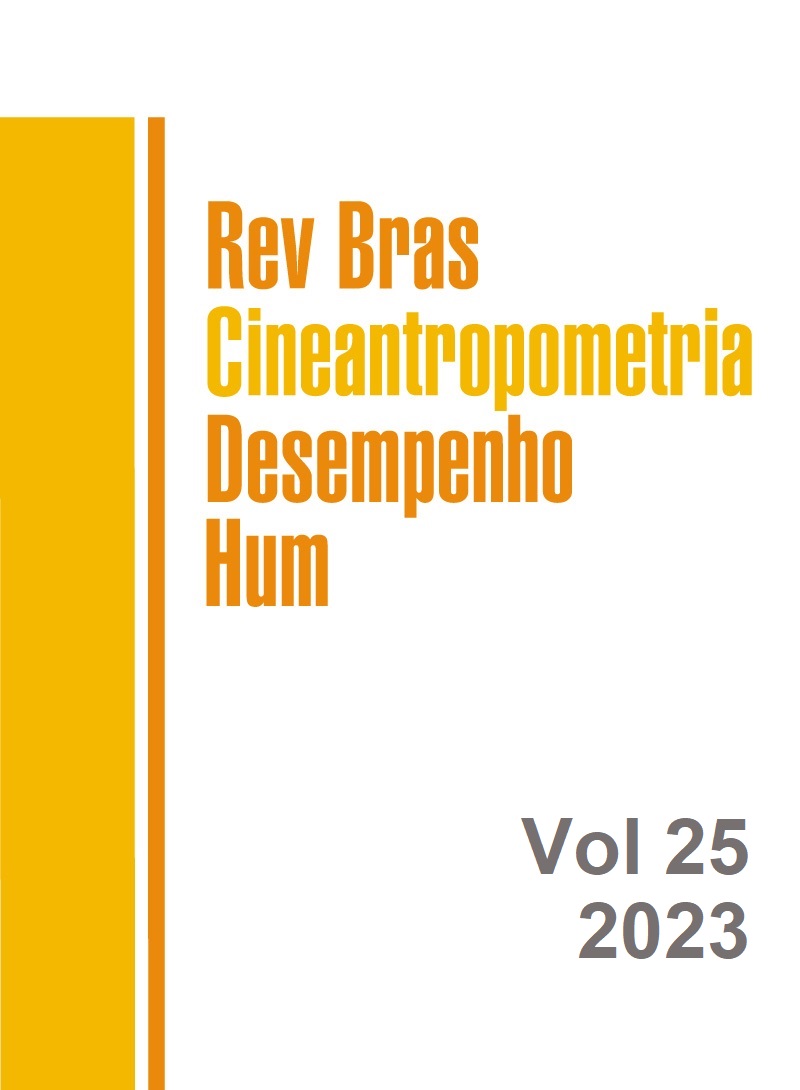Anthropometric characteristics and physical activity level of Orienteers: a pilot study
DOI:
https://doi.org/10.1590/1980-0037.2023v25e95102Palabras clave:
Anthropometry, Body composition, SomatotypesResumen
The present study aimed to describe a study protocol for Orienteers’ anthropometric characteristics and physical activity level. This is an individualized, observation and cross-sectional pilot study, that has encompassed three Orienteers (2 Portuguese men and 1 Spanish woman) with mean age 22.6 ± 3.78 years and 8.0 ± 2.64 consecutive years of Orientation practice. In total, 26 anthropometric variables were assessed: four basic measurements, nine skinfolds, nine girths and four breadths; Body Mass Index was calculated, as well as body composition and somatotype (according to the Heath-Carter method). The International Physical Activity Questionnaire – Short Form was used to obtain the score expressed as metabolic equivalent and the energy expenditure in kilocalories, both during the reference week. Mean somatotype recorded for Orienteering athletes could be defined as balanced mesomorph. Scores recorded for different physical activity/ inactivity expressed domains have shown high-energy expenditure. Sports Science Professionals can use the herein proposed protocol to improve Orienteers’ training.
Citas
Mottet M, Eccles DW, Saury J. Navigation in outdoor environments as an embodied, social, cultural, and situated experience: An empirical study of orienteering. Spat Cogn Comput. 2016;16(3):220-243. DOI: https://doi.org/10.1080/13875868.2016.1166229
IOF: International Orienteering Federation. [Internet]. Karlstad; 2023 [cited 2023 Jan 04]. Available from: https://orienteering.sport/
Machowska-Krupa W, Cych P. Differences in coordination motor abilities between orienteers and athletics runners. Int J Environ Res Public Health, 2023;20(3):2643. DOI: https://doi.org/10.3390/ijerph20032643
Davis PA, Sörman D, Carlberg A, Rognsvåg E, Stenling A. The psychophysiological influence of exertion and affect on sport-specific cognitive and physical performance. J Sci Med Sport. 2022;25(9):764-769. DOI: https://doi.org/10.1016/j.jsams.2022.05.008
Esparza-Ros F, Vaquero-Cristóbal R, Marfell-Jones M. Protocolo internacional para la valoración antropométrica. Perfil Completo. Murcia: International Society for the Advancement of Kinanthropometry - ISAK, 2019.
Muñoz CS, Muros JJ, Belmonte ÓL, Zabala M. Anthropometric characteristics, body composition and somatotype of elite male young runners. Int J Environ Res Public Health. 2020;17(2):674. DOI: https://doi.org/10.3390/ijerph17020674
Celestino TF de S, Leitão JCG de C, Pereira AM de A. Determinantes para a excelência na Orientação: as representações de treinadores e atletas de elite. Retos. 2019;35:91-6.
WMA: World Medical Association. World Medical Association Declaration of Helsinki: Ethical Principles for Medical Research Involving Human Subjects. JAMA. 310(20):2191-4. DOI: https://doi.org/10.1001/jama.2013.281053
Levine DM, Stephan DF, Szabat KA. Estatística: teoria e aplicações usando o Microsoft Excel® em Português. Rio de Janeiro: LTC; 2016.
Silva VS, Vieira MFS. International Society for the Advancement of Kinanthropometry (ISAK) Global: international accreditation scheme of the competent anthropometrist. Rev Bras Cineantropom Desempenho Hum. 2020;22:e70517. DOI: https://doi.org/10.1590/1980-0037.2020v22e70517
Liguori G, Feito Y, Fountaine C, Roy BA. Diretrizes do ACSM para os testes de esforço e sua prescrição, 11th ed. Rio de Janeiro: Guanabara Koogan; 2023.
Quetelet LAJ. Anthropométrie ou measure des différentes facultés de l'homme. Bruxelles: C. Muquardt; 1870.
Withers RT, Craig NP, Bourdon PC, Norton KI. Relative body fat and anthropometric prediction of body density of male athletes. Europ J Appl Physiol. 1987;56(2):191-200. DOI: https://doi.org/10.1007/BF00640643
Withers RT, Whittingham NO, Norton KI, La Forgia J, Ellis MW, Crockett A. Relative body fat and anthropometric prediction of body density of female athletes. Europ. J Appl Physiol. 1987;56(2):169-80. DOI: https://doi.org/10.1007/BF00640641
Martin AD. Anthropometric assessment of bone mineral. In: Himes JH, editors. Anthropometric assessment of nutritional status. New York: Wiley-Liss; 1991. p. 185-96.
Lee RC, Wang Z, Heo M, Ross R, Janssen I, Heymsfield SB. Total-body skeletal muscle mass: development and cross-validation of anthropometric prediction models. Am J Clin Nutr. 2000;72(3):796-803. DOI: https://doi.org/10.1093/ajcn/72.3.796
Carter JEL, Heath BH. Somatotyping: development and applications. Cambridge: Cambridge University Press; 1990.
International Society for the Advancement of Kinanthropometry/ISAK. KINANTHREPORT/ISAK NEWSLETTER: México. 2022;44:9 Available from: https://www.isak.global/Magazine/List
IPAQ: International Physical Activity Questionnaire. [Internet]. 2022 [cited 2023 Feb 25]. Available from: https://sites.google.com/view/ipaq/home
Sember V, Meh K, Sori? M, Starc G, Rocha P, Jurak G. Validity and reliability of International Physical Activity Questionnaires for adults across EU countries: systematic review and meta analysis. Int J Environ Res Public Health. 2020;17(19):7161. DOI: https://doi.org/10.3390/ijerph17197161
Ainsworth BE, Haskell WL, Whitt MC, Irwin ML, Swartz AM, Strath SJ, O'Brien WL, Bassett DR Jr, Schmitz KH, Emplaincourt PO, Jacobs DR Jr, Leon AS. Compendium of physical activities: an update of activity codes and MET intensities. Med Sci Sports Exerc. 2000;32(9):498-504. DOI: https://doi.org/10.1097/00005768-200009001-00009
Lee HP, Macfarlane DJ, Lam TH, Stewart SM. Validity of the International Physical Activity Questionnaire Short Form (IPAQ-SF): a systematic review. Int J Behav Nutr Phys Act. 2011;8:115. DOI: https://doi.org/10.1186/1479-5868-8-115
Nikolaidis PT, Rosemann T, Knechtle B. Skinfold thickness distribution in recreational marathon runners. Int J Environ Res Public Health. 2020;17(9):2978. DOI: https://doi.org/10.3390/ijerph17092978
Batista MM, Paludo AC, Gula JN, Pauli PH, Tartaruga MP. Physiological and cognitive demands of orienteering: a systematic review. Sport Sci Health. 2020;16(4):591-600. DOI: https://doi.org/10.1007/s11332-020-00650-6
Kuhl CC, Medeiros TE, Pauli PH, Martins MVS, Queiroga MR, Tartaruga MP, Batista MM. Relationship of simple reaction time and aerobic and anaerobic capacities with performance of recreational adult orienteers. Rev Bras Cineantropom Desempenho Hum. 2019;21:e55492. DOI: https://doi.org/10.1590/1980-0037.2019v21e55492
Descargas
Publicado
Número
Sección
Licencia

Direitos Autorais para artigos publicados nesta revista são do autor, com direitos de primeira publicação para a revista. Em virtude da aparecerem nesta revista de acesso público, os artigos são de uso gratuito, com atribuições próprias, em aplicações educacionais e não-comerciais, desde que seja dada a atribuição. Esta obra foi licenciada com uma Licença Creative Commons Atribuição 4.0 Internacional - CC BY


